Best For | Marketers and businesses needing highly flexible, visual funnel tracking with advanced customization for optimizing traffic and conversions. | Affiliate marketers and media buyers looking for AI-powered tracking, automation, and real-time analytics to scale ad campaigns efficiently. |
Price | $99 | $119 |
Features | Visual funnel builder & tracking | AI-powered ad campaign optimization |
Pros | Powerful visual funnel tracking | AI-driven campaign optimization |
Cons | Learning curve for beginners | Higher pricing for advanced plans |
Choosing the right affiliate tracking tool can be tough. With so many options out there, it’s easy to feel overwhelmed—every platform claims to be the best.
That’s why I’ve put together this detailed comparison of FunnelFlux Pro and Voluum, two of the most popular tracking tools in the industry.
Whether you’re just starting out in affiliate marketing or looking to switch platforms, this guide will help you understand what each tool offers and which one might be the better fit for you.
While most trackers offer similar basics—like tracking landing pages, offers, redirects, and generating reports—the real differences come down to ease of use and specific features.
Voluum is known as an industry leader, but FunnelFlux Pro is our top pick for a reason. It not only does the essentials well, but also brings a fresh approach and unique features that set it apart from the rest.
Bottom Line Upfront: FunnelFlux Pro is the best choice for you because this platform is capable of tracking your marketing campaigns on big platforms like Facebook, Google AdWords, and many more. Voluum is also a great platform when it comes to tracking your ad campaigns but it has flaws and it lacks some features other than FunnelFlux Pro. It doesn’t hurt to give FunnelFlux Pro a try than Voluum.
FunnelFlux vs Voluum: Overview
Funnelflux Pro Overview
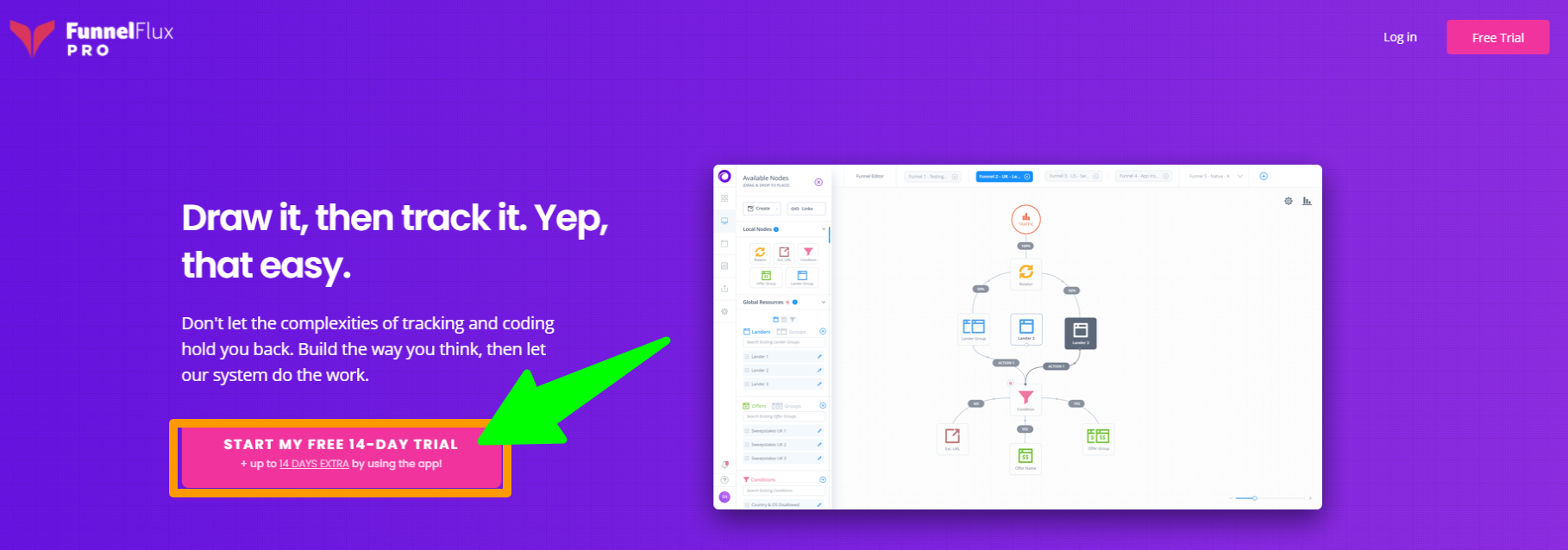
Using FunnelFlux, an effective reporting affiliate engine, you can track, sort, and find the traffic groups (like squeeze pages, CPA, and landing pages) that make you the most money with the least amount of work.
Here’s what I’m getting at.
Imagine that you don’t know which traffic routes are worth taking and which ones are a waste of time and money.
Or, if you’re trying to sell more of a product or service and are running more than one ad campaign, FunnelFlux can help you figure out which ads work best.
Voluum Overview
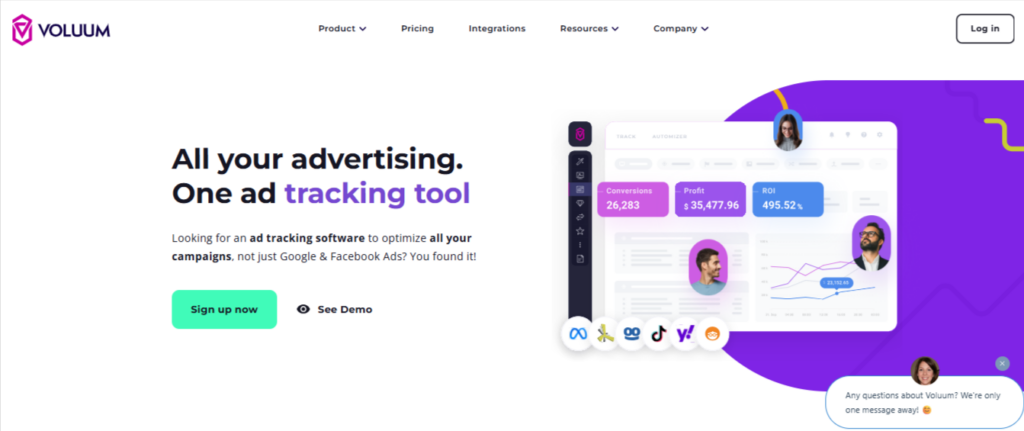
Voluum is the go-to tool for advertisers, affiliate marketers, and media buying teams when it comes to optimizing and measuring the efficacy of their online advertising campaigns.
The platform provides marketers with a suite of tools and services for monitoring, analyzing, and improving their efforts across various channels, including native, push, display, and mobile.
Funnelflux Pro As per My Experience
Well, imagine drawing a funnel on a whiteboard explaining how users will move between different pages, to upsells, downsells, one-time offers, email opt-ins followed by later pages sent via email, etc.
You’re basically drawing a flowchart, right? Here’s what building tracking can look like in FunnelFlux Pro:
FunnelFlux Pro lets you draw flowcharts to design your tracking. This creates a “funnel,” which can receive traffic from unlimited traffic sources, campaigns, and ads. You can grab URLs just by clicking a page and choosing a traffic source.

In virtually every other tracker, here is the process you go through when launching new campaigns:
- Create some flow or lander > offer combination in the tracker. Can usually reuse this.
- Pick a traffic source
- Sometimes, pick a country
- Fill out other details
- Save
- Get some unique campaign link only for that traffic source > flow and possibly the country
And then, when you want to run another campaign on the same source or another traffic source with the same flow:
- Duplicate some existing campaign
- Change the source or country
- Save it
- Get another unique link
- Go use that in your traffic source
Want to direct link? New campaign entirely, or add custom, ever-expanding rules to a campaign to make it change flows for specific campaign IDs, sources, etc. The result is hundreds of campaigns for every little thing, a lot to keep track of, and lots of configs.

Then when you get to reporting, it’s often by campaigns first, then you have to drill down into each of them to break down by creatives, devices, countries, and other URL parameters.
Sometimes, you can break down fully from traffic source > campaign > creative >, etc., but you will then run into limits to how many levels you can go to.
With FunnelFlux, here’s what you do:
- Create a funnel. It visually describes the flow of pages you expect a user to go through.
- Click on the traffic node > get links > pick source > copy link. That’s it, nothing to save.
- Go use that link in the traffic source.
Here’s what you do when you want to run a new campaign at the traffic source:
- Open the funnel or the edit dialog
- Click/select traffic node > generate link
- Copy > done
The links are dynamic, and you don’t need to save them. You don’t duplicate anything, you just grab the same link and reuse it. Everything like URL params and campaign IDs is passed dynamically in the URLs using tokens, so there is so much less needless duplication.
Now, when you want to break down data by campaign, you just group by the campaign parameter that was passed in the URL.
It’s so much easier!
As for the reporting breakdowns… you have two options, each of which has advantages over other trackers:
- On any page showing your resources – like funnels, traffic sources, landers, for any row, you can click to open a quick stats overlay that lets you instantly break down that data. By source, location data, device data, URL fields, everything. Hella fast.
- Go to the reporting page and build a custom report. You can group by up to a whopping 20 attributes, and there are some special ones like “visitor journey,” which breaks down the exact flow users went through and conversion rates, EPCs, etc. at each level.
This is just one of the key reasons why I like FunnelFlux Pro more… it breaks away from the standard mold that all other trackers seem to follow and does things differently.
Differences can sometimes be more confusing to adopt if you’re used to the other trackers… but people felt the same about Slack vs Skype (and look how that went) or Uber vs Taxis. You have to do things differently to find a better UX.
Let’s talk about some of the other cool things I like about FunnelFlux Pro:
Data Passing
I really like this one because I know in the past, especially when I was new, I screwed up URLs often and made mistakes with tokens, copy/paste, and editing, and wasted countless hours trying to fix things.
Or worse, I ran campaigns for days with broken data that made it hard to optimize.
In most trackers, you fill out a URL and inject tokens into them. You get long URLs, and they can be annoying to read, and it’s easy to make human error.
All it takes is putting ?something=x instead of &something=x, and it all goes to hell.
In FunnelFlux Pro, you just put some base URL then build all this finicky data passing like this:
Another UX thing I like. You just put the fields/values here and use their dropdowns so you don’t make mistakes.
Offers are templated by the network configuration, too, so you never make rookie mistakes when adding new offer links and don’t have to add all this stuff every time.
Conditions
I like to figure out traffic optimization quickly and what landers, offers, etc., work best for different countries, devices, and so on.
In many trackers, this can be a little annoying, especially if you want to do anything other than lander > offer flows.
In FunnelFlux Pro, you can add condition nodes anywhere, create rules with their names, and visually see how things are routing. Like this:
I find this much easier than lists of landers/offers where I create rule after rule. Here I can visually map things out.
I can add these conditions anywhere, too… For example, I can add a geo-routing condition before landing pages, then another one on clickthrough to offers, and so on. Users move from node to node in the funnel, and you can control decisions at any point.
Not only is this freakin’ cool, but I think it lets you dream up ways to get out higher ROI that you didn’t think of in other trackers.
Quick Stats
It’s just one of my favorite features because of the speed…
I go to the traffic sources page. I want to analyze a specific source. I click the quickstart button:
And boom, an overlay opens, breaking down the source by funnels. I can then jump to location data and in seconds get this breakdown:
For me, this is gold. I drill down via a fast overlay. When I close it, I am where I was before. I don’t have to jump between pages or open multiple tabs. It just feels more responsive, and the UI can keep up with my thought process.
JavaScript and No-Redirect Tracking
One last thing…
A lot of marketers now are directly linking to pages and using javascript to do their tracking.
It’s a must on platforms like Facebook and Google where they don’t like redirects (not necessarily banned), and marketers are afraid of using redirect links if it could risk account bans, ad disapprovals, etc.

Most trackers offer Javascript tracking, and FunnelFlux Pro does, too. But here is why I think it’s better:
- It’s kinda like Facebook JS, so it’s familiar. You place a global include, then fire events like page views on your pages and conversions elsewhere. The view includes a page ID and is the same for that lander, no matter what funnel it is used in or the campaign involved.
- You can embed defaults like funnel and traffic source, so organic traffic defaults to something you choose
- Their javascript is super smart and automatically injects tracking data into links so that stuff doesn’t break even when cookies and referrers are blocked. This alone makes it more reliable than other trackers, especially if running on Facebook, where their mobile browser blocks most third-party cookies.
- The javascript lets you use any tracker data — IDs, traffic source data, country, device model, etc. You don’t have to pass this in your URL! You can directly source it and use it in your page, JS functions, etc. I haven’t seen other trackers provide this.
- Because of the way it works, you can easily integrate with Google Tag Manager and use their lookup table feature to map out all your pages, and now you don’t need to place JS on pages at all, just GTM and add a page ID to the GTM setup. It can be tricky at first if you’re not used to GTM, but later, it makes everything easy
- Lastly, and this is super cool, you can link directly between pages (like on a Shopify site or product site) without using tracker links, and the JS will intelligently create click events in their system if an action connects the pages! This is great as it lets you track CTR without having to change links on your website. For Ecom platforms, this is critical as you often have no control over the links
Key Features Comparison: FunnelFlux vs. Voluum
Both FunnelFlux and Voluum are powerful tracking tools designed for marketers who want to optimize their campaigns. However, they have different strengths and features. Below is a detailed comparison of their key features to help you understand which one is the best fit for your needs.
1. Tracking & Data Management
- FunnelFlux: Allows unlimited tracking events in its self-hosted version, meaning you can track as much data as you want without extra costs. The cloud-hosted version includes 2 million events per month, with additional events costing $5 per million.
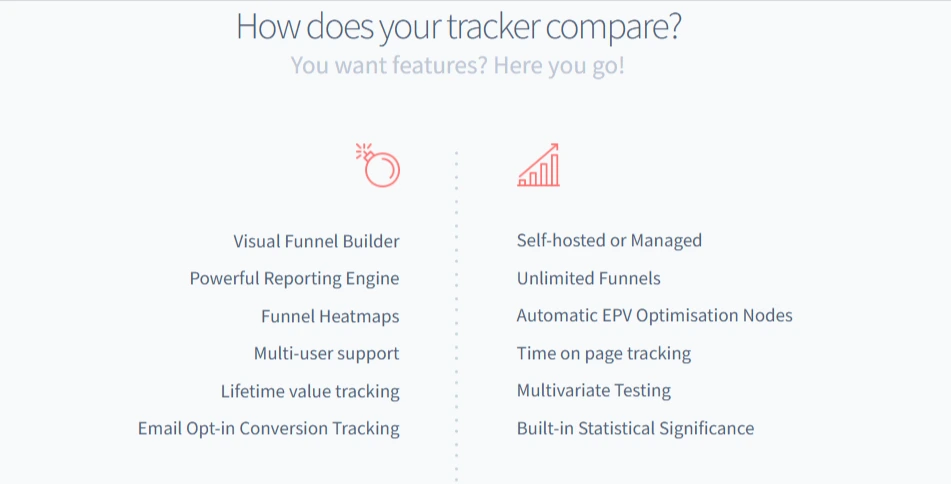
- Voluum: Offers limited tracking events based on the plan you choose. The entry-level plan allows 1 million events per month, while higher-tier plans support up to 60 million events. If you need more, you’ll have to upgrade to a pricier plan.

Winner: FunnelFlux is better for those who want unlimited tracking without extra charges.
2. Hosting & Setup
- FunnelFlux: Offers two hosting options—a self-hosted version where you install it on your own server and a cloud-hosted version that is managed for you. The self-hosted version gives you full control, but you need to handle your own server.
- Voluum: Fully cloud-hosted, meaning there’s no need for installation or server setup. Everything is managed for you, but you don’t have as much control over customization.
Winner: If you want full control, FunnelFlux (self-hosted) is the better choice. If you prefer an easy, no-maintenance solution, Voluum wins.
3. Funnel Building & Traffic Control
- FunnelFlux: One of its biggest advantages is its visual funnel builder. You can drag and drop traffic flows, set up detailed rules, and split-test different landing pages. It’s great for marketers who need complete flexibility over their funnels.
- Voluum: Focuses more on AI-powered tracking and automation rather than visual funnel building. While it allows traffic splitting and campaign optimization, it lacks a drag-and-drop funnel builder like FunnelFlux.
Winner: FunnelFlux is the clear winner for marketers who need detailed traffic flow customization.
4. Reporting & Analytics
- FunnelFlux: Provides real-time analytics with custom reporting options. The visual interface makes it easy to understand how traffic flows through different steps.
- Voluum: Offers real-time tracking with advanced AI-powered analytics, including fraud detection, bot filtering, and multi-channel tracking. It’s great for affiliate marketers running paid ad campaigns.
Winner: Voluum wins for AI-powered analytics, while FunnelFlux is better for visual reporting and custom tracking setups.
5. Integrations & Automation
- FunnelFlux: Integrates with any traffic source, CRM, or affiliate network using API and postback tracking. However, it does not have pre-built automation for ad campaign optimization.
- Voluum: Has built-in integrations with Facebook, Google Ads, and other ad networks. It also includes AI-driven automation to help optimize campaigns automatically.
Winner: Voluum is the better option if you need ad network integrations and automation.
6. Security & Data Privacy
- FunnelFlux: Since the self-hosted version runs on your own server, your data is 100% private. The cloud version is also secure, but data storage depends on FunnelFlux’s servers.
- Voluum: Stores all tracking data on its cloud servers with security measures like traffic filtering and fraud detection. However, users don’t have full control over their data.
Winner: FunnelFlux (self-hosted) is better for those who want full control over their data.
7. FunnelFlux vs. Voluum: Cost Comparison
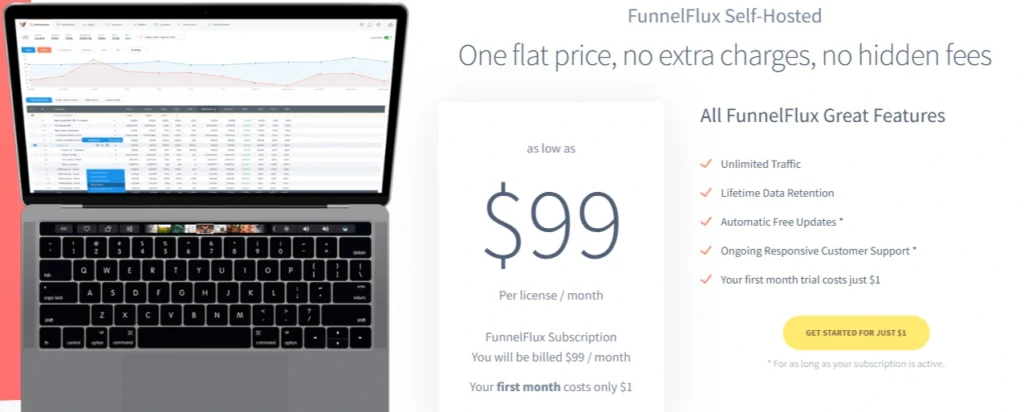
Here’s a side-by-side comparison of FunnelFlux and Voluum pricing to help you decide which one fits your needs best.
| Feature | FunnelFlux (Self-Hosted) | FunnelFlux Pro (Cloud-Hosted) | Voluum Profit | Voluum Scale | Voluum Start-Up | Voluum Agency | Voluum Enterprise |
|---|---|---|---|---|---|---|---|
| Starting Price | $99/month | $99/month | $119/month | $299/month | $529/month | $751/month | $1,551/month |
| Hosting Type | Self-hosted (requires own server) | Fully managed (cloud-hosted) | Cloud-hosted | Cloud-hosted | Cloud-hosted | Cloud-hosted | Cloud-hosted |
| Tracking Events | Unlimited | 2 million (extra $5/million) | 1 million | 5 million | 10 million | 25 million | 60 million |
| Campaign Limit | Unlimited | Unlimited | 20 campaigns | 60 campaigns | Unlimited | Unlimited | Unlimited |
| Data Storage | Lifetime | Unlimited | 6 months | 12 months | 12 months | 18 months | 24 months |
| Custom Domains | No limit | No limit | 3 | 5 | Not specified | Not specified | Not specified |
| API Access | No | No | No | No | Yes | Yes | Yes |
| Dedicated Support | Standard support | Standard support | No | No | Basic Support | Account Manager | VIP Support |
| Refund Policy | 30-day trial for $1 + 3-day refund guarantee | 30-day trial for $1 + 3-day refund guarantee | No refund policy | No refund policy | No refund policy | No refund policy | No refund policy |
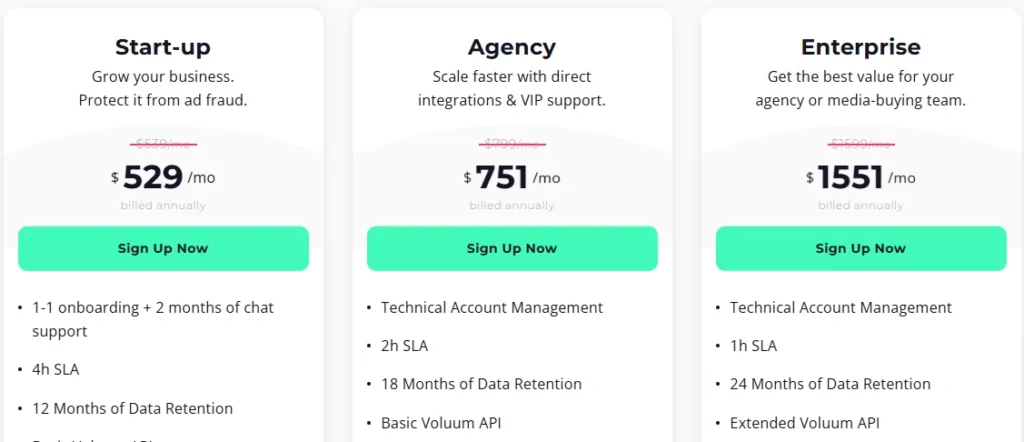
Key Differences:
- FunnelFlux offers unlimited tracking in its self-hosted plan, while Voluum limits events based on the plan.
- FunnelFlux Pro (Cloud-Hosted) starts at $99/month, whereas Voluum’s cheapest plan starts at $119/month.
- Voluum has structured business plans with dedicated support, while FunnelFlux is more flexible and includes a risk-free $1 trial.
Winner: FunnelFlux is more affordable, especially for marketers who need unlimited tracking.
FunnelFlux vs Voluum: Pros and Cons
FunnelFlux Pros
- The FunnelFlux statistics module offers a great deal of flexibility.
- Without autoresponders, estimate your leads’ lifetime value.
- Fast affiliate tracking software. A $14.88 VPS gets 1M+ ticks every day.
- When it comes to assessing and improving a number of campaigns, it is incredibly accurate.
- It offers effective customer service support to assist you with any questions you might have.
- It contains a visual funnel heatmap graph that you can use to keep track of each campaign you’ve run.
- It automatically monitors more than sixty different Key Performance Indicators (KPIs).
- A visual funnel builder is included for quick and simple funnel development.
- It enables you to examine and understand the conversion rates of the landing pages of your rivals.
FunnelFlux Cons
- It will take a long time to learn and apply it.
- FunnelFlux cannot develop landing pages without third-party software.
Voluum Pros
- With Voluum, advertisers and promoters can anticipate live updates
- Tracking Domains with SSL
- It is very easy to use
- Voluum’s tracking, reporting, and A/B testing are popular. The software helps advertisers track traffic source revenue and campaign performance.
- Direct Tracking Pixel
- Outstanding Customer Service: Reviewers give Voluum’s account managers high marks because they reply quickly and offer personalized solutions. The staff helps many users with problems and questions about the platform.
Voluum Cons
- Complex Setup: The software’s many tabs and capabilities can be confusing for first-time users.
- Voluum’s Automizer, Fraud Analytics, and Extra Users charges made it pricey for some users.
Quick Links:
- Voluum vs CPV One
- Trackier Vs Voluum
- Best Funnelflux Alternatives
- ClickMagick Vs Voluum Vs Clickmeter
FAQs About FunnelFlux vs. Voluum
What is the main difference between FunnelFlux and Voluum?
FunnelFlux is best for marketers who want full control over their traffic flow with a visual funnel builder and unlimited tracking in its self-hosted version. Voluum, on the other hand, is great for affiliate marketers who need AI-powered tracking, automation, and built-in ad network integrations.
Which one is better for tracking unlimited events?
FunnelFlux’s self-hosted version lets you track unlimited events with no extra cost. Voluum limits tracking based on your plan, starting at 1 million events per month in the Profit Plan. If you run high-volume campaigns, FunnelFlux is the better choice.
Which one is easier to use?
Voluum is easier to set up since it’s fully cloud-hosted, meaning you don’t need to install anything. FunnelFlux (self-hosted) requires you to set up your own server, but the cloud version removes that hassle. However, FunnelFlux’s visual funnel builder makes traffic flow management more intuitive.
Does FunnelFlux or Voluum have better automation?
Voluum has built-in AI-powered automation, making it great for scaling ad campaigns without manual adjustments. FunnelFlux doesn’t have built-in automation, but it gives more flexibility in custom tracking setups.
Can I integrate these tools with ad networks like Facebook and Google Ads?
Yes, but Voluum has direct integrations with platforms like Facebook, Google Ads, and other ad networks. FunnelFlux allows custom integrations with any traffic source, but it doesn’t have pre-built integrations like Voluum.
Conclusion: FunnelFlux vs Voluum 2025
In this battle, I think it comes down to whether you want the most mature, oldest tracker and can deal with its price-locking of features, or want the cheaper, more flexible FunnelFlux Pro and are OK with it not (yet) being as feature rich and being new to the market (as a SaaS offering at least).
FunnelFlux can fundamentally track more situations and complex funnels than Voluum and has a different approach to tracking. If you like the visual aspect and want to build funnels, like their UI, link generation approach etc. then go for them.
Our recommendation goes to FunnelFlux Pro since it is cheaper for most, has a newer and more flexible approach to tracking, has good support, is fast, and, importantly, doesn’t force you to upgrade (sometimes to almost $500/mo) just to have some of its features.


